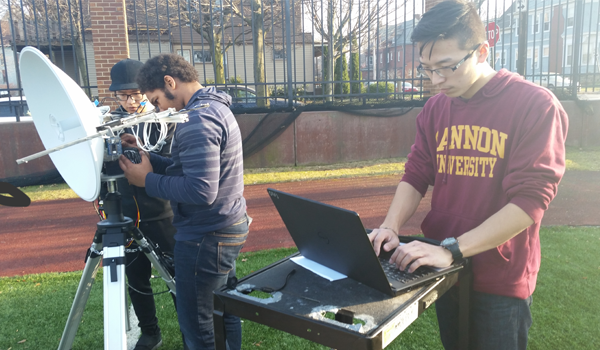Innovation is launched at the intersection of different disciplines, of diverse experts and of open minds. Cross-disciplinary projects bring together students and faculty, such as the team working on a NASA-funded project to livestream the solar eclipse using a student-designed payload sent to near space.

How far will Gannon University students go to pursue a once-in-a-lifetime research opportunity? How about 80,000 feet.
That’s how far above Earth’s surface a package of instruments will ascend via high-altitude balloon to record and livestream the solar eclipse in August.
The instruments were designed by a team of undergraduate students led by Wookwon Lee, Ph.D., associate professor of electrical and computer engineering, and Nick Conklin, Ph.D., associate professor of physics, as part of a national project funded by a NASA Space Grant. The Gannon team is part of a select group of 52 colleges and universities nationwide and one of three from Pennsylvania selected to conduct balloon flights from about 25 locations across the total eclipse path.
Maia MacKellar, a junior electrical engineering major, is part of the Gannon University team that will travel to Hopkinsville, Kentucky, north of Nashville, for the Aug. 21 launch. MacKellar will man the team’s ground station to track the instrument package so that it can be recovered after the flight. She will also assist with the live video stream. “The plan is to see [the eclipse] from Oregon to the southern U.S. using multiple teams,” she said. “We can’t wait. We’re really excited about it!”
The coast-to-coast project will return video images of the solar eclipse, something that has never been done live, nor in a network of coverage spanning a continent.
“The plan is to see [the eclipse] from Oregon to the southern U.S. using multiple teams. We’re really excited about it.”
Totality, the amount of time that the moon’s disc will completely cover the sun revealing the sun’s tenuous atmosphere or corona, will last two minutes and 40 seconds at the Kentucky location, the greatest amount of totality at any place in the continental U.S.
A total eclipse is one of nature’s most awe-inspiring sights. Roughly 12 million people live within the path of totality, and another 40 million within a few hours’ drive. Adding the millions more who will watch the livestream will make the August eclipse one of the most witnessed natural events in history. And it will be brought to you as it happens from the edge of space by a package of instruments created by Gannon University students.
High Altitude Balloon Launch - August 21, 2017, 1-4 p.m. EDT
View the LIVESTREAM at StreamEclipse.Live